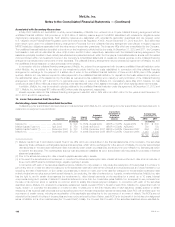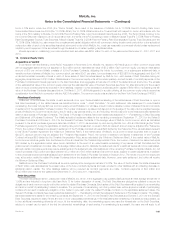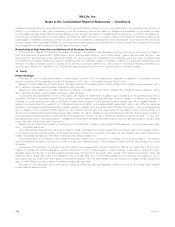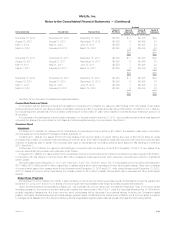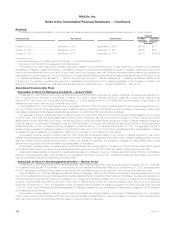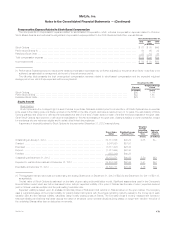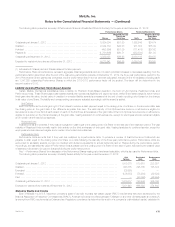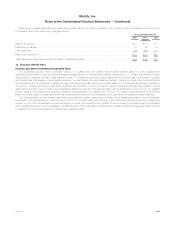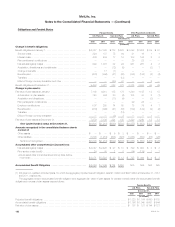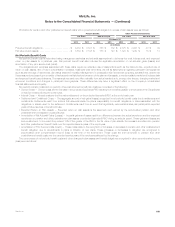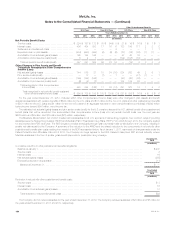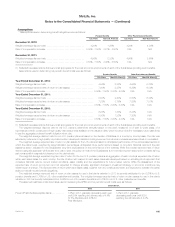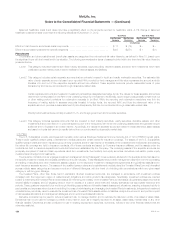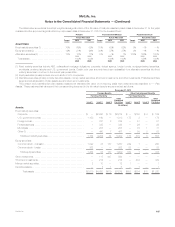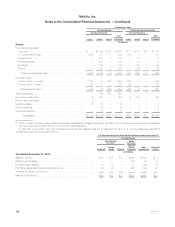MetLife 2012 Annual Report Download - page 184
Download and view the complete annual report
Please find page 184 of the 2012 MetLife annual report below. You can navigate through the pages in the report by either clicking on the pages listed below, or by using the keyword search tool below to find specific information within the annual report.
MetLife, Inc.
Notes to the Consolidated Financial Statements — (Continued)
assets or unrealized profits on investments) as of the last filed annual statutory statement requires insurance regulatory approval. Under Connecticut
State Insurance Law, the Connecticut Commissioner has broad discretion in determining whether the financial condition of a stock life insurance
company would support the payment of such dividends to its stockholders.
Under the Rhode Island Insurance Code, Metropolitan Property and Casualty Insurance Company (“MPC”) is permitted, without prior insurance
regulatory clearance, to pay a stockholder dividend to MetLife, Inc. as long as the aggregate amount of all such dividends in any 12 month period does
not exceed the lesser of: (i) 10% of its surplus to policyholders as of the end of the immediately preceding calendar year; or (ii) net income, not including
realized capital gains, for the immediately preceding calendar year, not including pro rata distributions of MPC’s own securities. In determining whether a
dividend is extraordinary, MPC may include carry forward net income from the previous two calendar years, excluding realized capital gains less
dividends paid in the second and immediately preceding calendar years. MPC will be permitted to pay a dividend to MetLife, Inc. in excess of the lesser
of such two amounts only if it files notice of its intention to declare such a dividend and the amount thereof with the Rhode Island Commissioner of
Insurance (the “Rhode Island Commissioner”) and the Rhode Island Commissioner either approves the distribution of the dividend or does not
disapprove the distribution within 30 days of its filing. Under the Rhode Island Insurance Code, the Rhode Island Commissioner has broad discretion in
determining whether the financial condition of a stock property and casualty insurance company would support the payment of such dividends to its
stockholders.
Under Missouri State Insurance Law, MetLife Investors Insurance Company (“MLIIC”) is permitted, without prior insurance regulatory clearance, to
pay a stockholder dividend to MetLife, Inc. as long as the amount of the dividend when aggregated with all other dividends in the preceding 12 months
does not exceed the greater of: (i) 10% of its surplus to policyholders as of the end of the immediately preceding calendar year; or (ii) its statutory net
gain from operations for the immediately preceding calendar year (excluding net realized capital gains). MLIIC will be permitted to pay a cash dividend to
its parent in excess of the greater of such two amounts only if it files notice of the declaration of such a dividend and the amount thereof with the
Missouri Director of Insurance (the “Missouri Director”) and the Missouri Director either approves the distribution of the dividend or does not disapprove
the distribution within 30 days of its filing. In addition, any dividend that exceeds earned surplus (defined by the Company as “unassigned funds
(surplus)”) as of the last filed annual statutory statement requires insurance regulatory approval. Under Missouri State Insurance Law, the Missouri
Director has broad discretion in determining whether the financial condition of a stock life insurance company would support the payment of such
dividends to its stockholders.
MetLife, Inc.
In addition to regulatory restrictions on the payment of dividends by its subsidiaries to MetLife, Inc., the payment of dividends by MetLife, Inc. to its
stockholders is also subject to restrictions. The declaration and payment of dividends is subject to the discretion of MetLife, Inc.’s Board of Directors,
and will depend on its financial condition, results of operations, cash requirements, future prospects and other factors deemed relevant by the board. In
addition, the payment of dividends on MetLife, Inc.’s common stock, and MetLife, Inc.’s ability to repurchase its common stock, may be subject to
restrictions arising out of regulation by the Federal Reserve if, in the future, MetLife, Inc. is designated by the Financial Stability Oversight Council
(“FSOC”) as a non-bank systemically important financial institution (“non-bank SIFI”), as described below. They are also subject to restrictions under the
terms of MetLife, Inc.’s preferred stock, junior subordinated debentures and trust securities in situations where MetLife, Inc. may be experiencing
financial stress, as described below. For purposes of this discussion, “junior subordinated debentures” are deemed to include MetLife, Inc.’s Fixed-to-
Floating Rate Exchangeable Surplus Trust Securities, which are exchangeable at the option of MetLife, Inc., or in the future upon the occurrence of
certain events, for junior subordinated debentures, and which contain terms with the same substantive effects described in this discussion as the terms
in MetLife’s junior subordinated debentures.
Regulatory Restrictions. As discussed in Note 3, MetLife, Inc. has de-registered as a bank holding company. As a result, MetLife, Inc. is no longer
regulated as a bank holding company or subject to enhanced supervision and prudential standards as a bank holding company with assets of $50
billion or more. However, if, in the future, MetLife, Inc. is designated by the FSOC as a non-bank SIFI, it could once again be subject to regulation by the
Federal Reserve and enhanced supervision and prudential standards. While the Federal Reserve has proposed a set of prudential standards that would
apply to non-bank SIFIs, as well as bank holding companies with assets of $50 billion or more, it has not yet adopted final rules for most of these
standards. The Federal Reserve has stated its intention to take a tailored approach to applying the prudential standards to non-bank SIFIs, but has not
provided any details on how it intends to do so. If MetLife, Inc. were designated as a non-bank SIFI by the FSOC, the associated enhanced prudential
standards imposed could adversely affect MetLife, Inc.’s ability to pay dividends to its stockholders, as well as repurchase its common stock. In
addition, if MetLife, Inc. is designated as a global systemically important insurer (“G-SII”) by the Financial Stability Board, it would be subject to policy
measures which could include higher capital requirements and more intensive regulation. These policy measures would need to be implemented by
regulation or legislation in relevant jurisdictions but could limit MetLife, Inc.’s ability to pay dividends to its stockholders and repurchase its common
stock.
“Dividend Stopper” Provisions in the Preferred Stock and Junior Subordinated Debentures. Certain terms of MetLife, Inc.’s preferred stock and junior
subordinated debentures (sometimes referred to as “dividend stoppers”) may prevent it from repurchasing its common or preferred stock or paying
dividends on its common or preferred stock in certain circumstances. Under the preferred stock, if, for any reason, including due to a determination by
the MetLife, Inc. Board of Directors, MetLife, Inc. has not paid the full dividends on its preferred stock for a dividend period (i.e., the period from and
including a preferred stock dividend payment date to, but excluding the next preferred stock dividend payment date), it may not repurchase or pay
dividends on its common stock for that period. Under the junior subordinated debentures, if MetLife, Inc. has not paid in full the accrued interest on its
junior subordinated debentures through the most recent interest payment date, it may not repurchase or pay dividends on its common stock or other
capital stock (including the preferred stock), subject to certain exceptions. The junior subordinated debentures provide that MetLife may, at its option
and provided that certain conditions are met, defer payment of interest without giving rise to an event of default for periods of up to 10 years (although
after five years MetLife, Inc. would be obligated to use commercially reasonable efforts to sell equity securities to raise proceeds to pay the interest), with
no limitation on the number of deferral periods that MetLife, Inc. may begin, so long as all accrued and unpaid interest is paid with respect to prior
deferral periods. If MetLife, Inc. were to elect to defer payments of interest, the “dividend stopper” provisions in the junior subordinated debentures
would thus prevent MetLife, Inc. from repurchasing or paying dividends on its common stock or other capital stock (including the preferred stock) during
the period of deferral, subject to exceptions.
178 MetLife, Inc.


